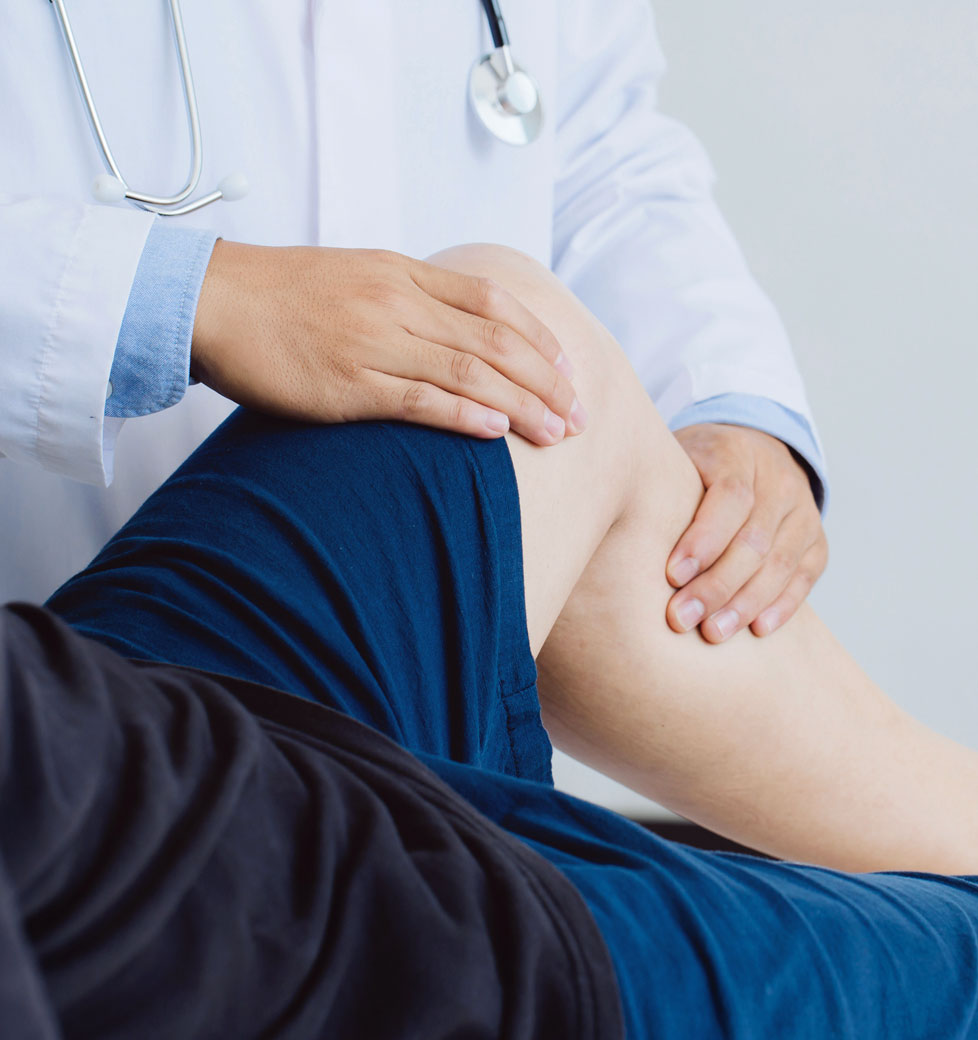Our simple, minimally-invasive procedures target areas of arthritis and your injuries to relieve pain and restore function.*
*These statements have not been evaluated by the FDA. Innate healthcare Institute makes no claim to diagnose, treat, cure, or prevent any disease.
Success Stories
See what our patients say about our orthopedic and sports injury therapy:
“I thought it was a placebo effect at first. But within a few weeks, I was sleeping without pain, I have about 70% of motion back and I’m getting more and more active each week. In total, I’m about 80% pain-free. The treatment saved my career.”
– Bill R., Phoenix, AZ
“I’ve struggled with low back pain since my 20’s, I was a basketball player, had an accident and had surgery. Since then I’ve struggled with low back pain…I had to stop playing basketball, learned to walk again over 6 months. The pain got more and more frequent, it was a 10 out of 10 pain. I tried drugs…was offered to have another surgery but with having a son I couldn’t take 6 months off for recovery. Another doctor recommended I look into a regenerative procedure. I’ve been dealing with this pain for 20 years so I had nothing to lose. Since the treatment I noticed a change in 2 weeks, wasn’t having pain while trying to sleep, I’m working out 5 days a week with no pain. I have zero pain now. It’s been 8 months and the pain hasn’t come back. There was no time in a hospital. I’m getting stronger little by little with exercising.”
– Jenny R., Phoenix, AZ, Former College Basketball Star
“I had extreme pain in both knees, toes, and my thumb… my only option was surgery and I wanted an alternative so I could play with my grandkids. I didn’t want the recovery and downtime with the surgery. I had both my knees done and IV treatments with regenerative medicine. I don’t have any pain in my toes…I have no pain in my knees…I can play with my grandkids, go up and down hills… I’m back golfing 18 holes. I was at an 8/10 pain and now I have zero pain…no pain in the mornings, waking me up.”
– Deb S., Phoenix, AZ
“Being in the nursing field for over 50 yrs left me with bad knees and hips…I had a total knee replacement on left knee which went well. For my right knee I started researching other options and found regenerative medicine. I came in and had my right knee done and did really well, and my hips. My hips are well but not as well as my knee…the next day it was better…after a month there was no pain. I was bone on bone. The rehab from the knee replacement was very difficult. Now I workout 4 days a week, I continued to workout even after the treatment. I do cardio classes and don’t have any pain in my knee during exercise, before I did…I’m much more functional and comfortable doing what I want to do…I think this is a great option to try before surgery…to me this makes 100% sense to do.”
– Marilyn Gardner, Phoenix, AZ


Changing the way we heal.
We’re learning that the body’s natural repair systems can be activated and supported in powerful ways—especially in orthopedics and sports injuries. Regenerative science is shifting focus from replacement to modulation and communication, helping guide healing rather than forcing it.
Our approach focuses on biological signaling and immune modulation to create the right environment for repair.
Here’s how regenerative mechanisms may support tissue recovery:
- Paracrine signaling — Cells release extracellular vesicles and signaling molecules (e.g., proteins, mRNAs, microRNAs, lipids) that influence nearby cells—like “cellular messengers” helping coordinate the repair response.
- Tissue preservation & cell viability — Modulating gene expression pathways (e.g., COX2, MMP13, COL10A1) may support joint tissue health by reducing degeneration associated activity.
- Inflammation resolution — Certain biological therapies have been observed in research settings to downregulate pro inflammatory signals like TNF α, IL 1β, and IL 6, contributing to a calmer immune environment that’s more conducive to healing.
- Chondrocyte support — Some regenerative signals may promote cartilage cell (chondrocyte) proliferation and matrix production—key for joint health.
- Angiogenesis — Stimulating blood vessel formation improves nutrient delivery and waste clearance, which can be essential for tissue recovery in low vascular zones like joints and tendons.
- Osteoarthritis modulation (under study) — Several studies are exploring how these mechanisms might help slow or modify the progression of degenerative joint conditions.

The Research
Interest in regenerative medicine techniques, such as platelet-rich plasma (PRP), prolotherapy, and umbilical cord–derived biologics, has grown significantly in orthopedics over the past two decades. While some therapies like PRP are widely used in clinical practice, other products—including those derived from umbilical cord tissue—are still investigational in the United States and not FDA-approved for treating orthopedic conditions.
Medicinal Signaling Cells (MSCs) found in umbilical cord tissue have been the subject of laboratory and clinical research due to their unique signaling capabilities. Studies have shown that MSCs can:
- Migrate to sites of inflammation or tissue injury
- Release trophic factors and extracellular vesicles (including exosomes) that influence local cell behavior
- Promote angiogenesis (blood vessel formation) and modulate the immune environment
- Help create conditions that support tissue remodeling and repair in experimental models
A systematic review published in 2020 (Ann Transl Med, 2021;9(6):452) analyzed multiple clinical studies evaluating umbilical cord–derived MSCs for knee osteoarthritis (OA). The review concluded that many studies reported improvements in pain and joint function, though results varied and long-term safety and effectiveness remain under investigation.
Researchers noted that how cell products are processed—including donor screening, lab culture methods, and quality controls—may influence biological activity in studies. This highlights the importance of standardization and regulatory oversight in future clinical development.
“Once kids started school in August I was out running about 3 miles every day. It was amazing and my body felt great. I stopped because… I found out I’m pregnant! I am so thankful for your clinic. It’s like I have been given a second chance at life. I feel better than I have in years.”

What To Expect
How it works
Every few weeks, we check in. We track what’s improving, what isn’t, and adjust your plan. If something doesn’t serve you, we pause or change it. You’re never locked into a path.
“We build plans the S.T.E.M. way—Safety-first. Transparent. Evidence-informed. Mindful.”
Your body is built to repair itself—but sometimes it needs help getting that process back on track. Regenerative medicine doesn’t try to force healing; it aims to support and guide your body’s own systems to do what they’re designed to do.
Here’s how many regenerative therapies may work in principle:
- Signal the body to repair – Certain therapies release molecules that act like messengers, encouraging nearby cells to begin the repair process. These are called paracrine signals, and they may include proteins, growth factors, and tiny particles called extracellular vesicles.
- Calm unnecessary inflammation – Chronic inflammation can prevent healing. Regenerative therapies may help the body dial down overactive immune responses, making space for repair to occur.
- Support new blood flow – Healing tissue needs oxygen and nutrients. Some regenerative approaches promote angiogenesis—the growth of new blood vessels—to nourish the area and clear waste.
- Promote tissue remodeling – By shifting the signals in an injured area, some therapies may help the body break down damaged tissue and begin laying down new, healthier structures over time.
- Improve the local environment – Even if cells don’t “become” new tissue, they can change the biological neighborhood—making it safer, more stable, and more regenerative.
We we love it
It’s care that works with your body, not against it.
When it comes to orthopedic pain and sports injuries, regenerative medicine gives us a way to support recovery without immediately reaching for surgery or long courses of medications. We love this approach because it’s:
Less invasive than surgery
Many regenerative strategies can be done in-office with minimal downtime—no incisions, no general anesthesia, and fewer risks. Whether it’s platelet-rich plasma (PRP) or other methods, we often start with the least-invasive option that makes the most sense for your goals.
Function-focused, not just symptom-based
Pain relief is important—but so is getting back to the way you move, work, train, and live. We design care plans that support tissue recovery, joint function, and long-term mobility, not just masking symptoms.
A smarter, more targeted alternative to “watch and wait”
Instead of hoping rest or anti-inflammatories do the job, regenerative medicine allows us to actively engage your body’s healing mechanisms through movement strategies, biologic signaling, and targeted recovery tools like PEMF therapy.
Often more personalized than conventional care
You’re not a protocol. Our regenerative plans are tailored to your injury, activity level, and lifestyle. We collaborate with you to track what’s improving—and what isn’t—so you’re never stuck in a passive role.
Schedule a Consultation
Your next step is to schedule a consultation with our team. Click the button below to get started. If you prefer immediate assistance, please call us at 602-603-3118.
